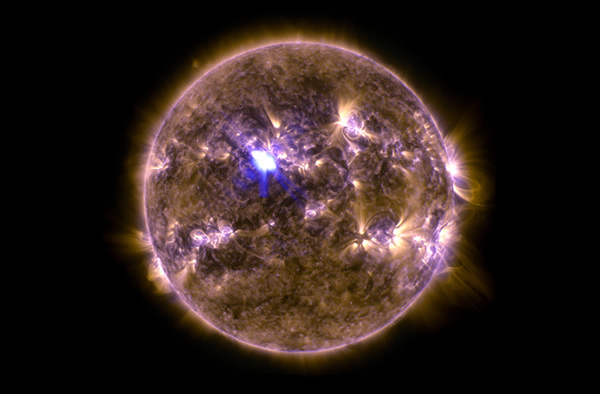Incoming! Sun Erupts With Huge Flare, Launches CME
The sun has unleashed the biggest solar flare of the year, quickly followed by an Earth-directed coronal mass ejection (CME). Both phenomena have the potential to impact communications and electronics on Earth and in orbit.
Although the sun is currently experiencing “solar maximum” — the culmination of its approximate 11-year cycle — scientists have noted that this particular maximum is a lot quieter than predicted. At this time, the sun should be bubbling with violent active regions, exhibiting sunspots, popping off flares and ejecting CMEs. But so far, the sun seems to be taking it relatively easy.
Incoming! Sun Erupts With Huge Flare, Launches CME
That was before today, however.
This morning (at 0716 UT), active region (AR) 1719 erupted with an M-class flare. With a rating of M6.5, this event is the most energetic flare of 2013 (although it’s a lot less impressive than 2012′s X-class fireworks). What’s more, the site of the explosion unleashed a CME in our direction.
A CME is a magnetic ‘bubble’ containing high-energy solar particles. When the CME hits Earth’s global magnetic field, it may align just right to generate a geomagnetic storm. Should this happen, we’ll be able to measure the extreme magnetic distortion of the magnetosphere and bright aurorae at high latitudes may result. Aurorae are caused when solar particles are injected into the polar regions via the Earth’s magnetic field — the particles then collide with atmospheric gases, generating a beautiful light display.
This morning’s CME was clocked traveling at a breakneck speed of 600 miles per second — at that rate it should hit Earth in the early hours of Saturday morning (April 13).
Shortly after the M-class flare erupted, a weak solar energetic particle (SEP) event was detected. This “radiation storm” was the result of relativistic particles slamming into the Earth’s upper atmosphere originating from the flare site.
The impact of radiation storms and geomagnetic storms do not directly threaten life on Earth, although there can be consequences for our high-tech society. The Earth’s magnetic field and thick atmosphere deflects and mops up the radiation and high-energy particles from the sun, but radiation storms can cause fluctuations in the electron content of the ionosphere, one of the uppermost regions of the atmosphere. This can interfere with planet-wide radio communications. Also, when the CME hits, and if the magnetic conditions are right, vast electrical currents can be induced through the atmosphere, potentially impacting regional electrical grids. Also, satellites are vulnerable in the high-energy space weather environment.
Fortunately, with the help of NASA, the NOAA and other global space weather efforts, we are getting better at predicting the impact of space weather on our planet so we can prepare for the worst case scenario.
Apr 11, 2013 03:00 PM ET by Ian O'Neill












